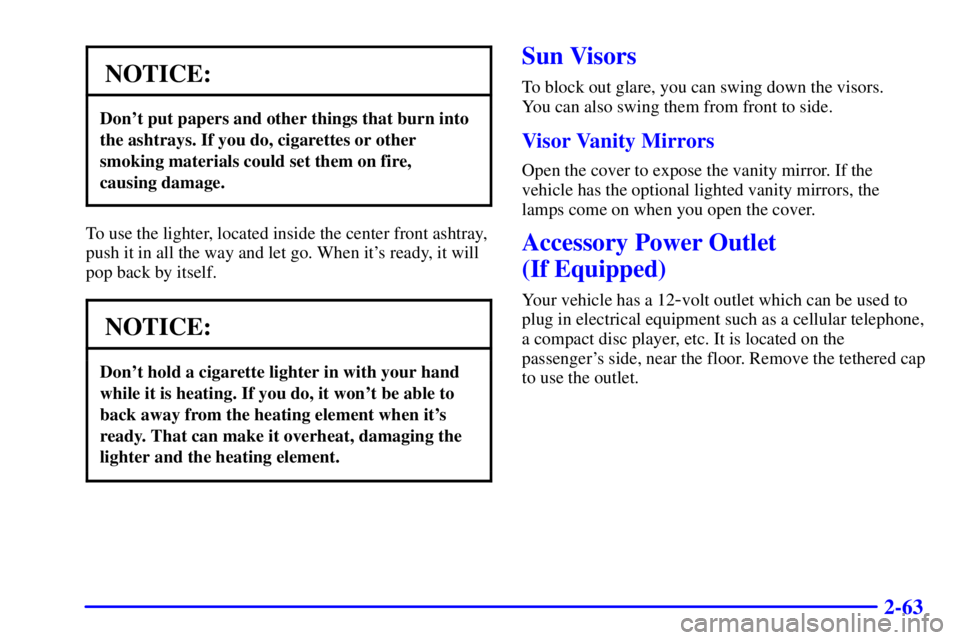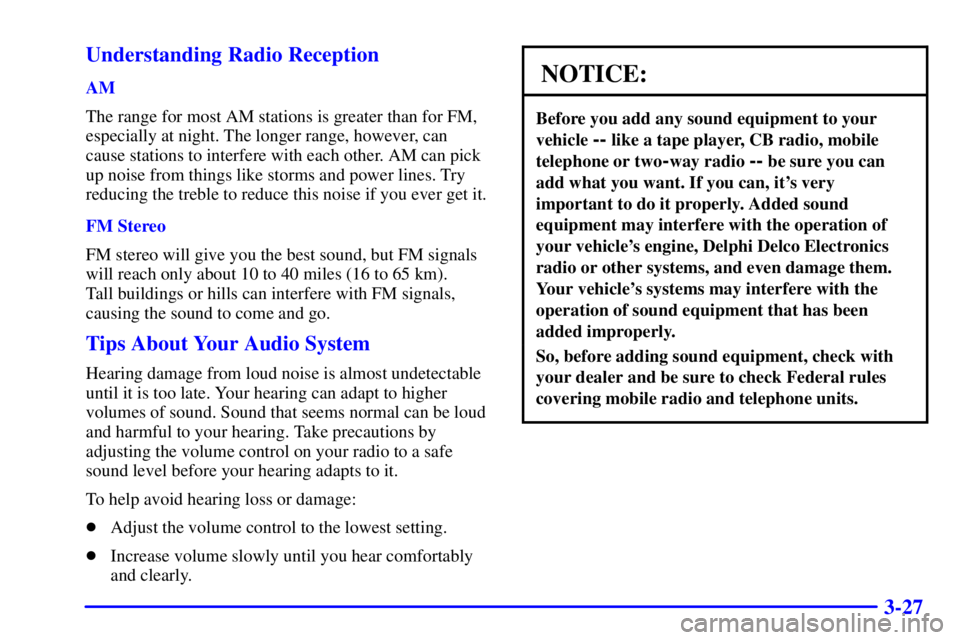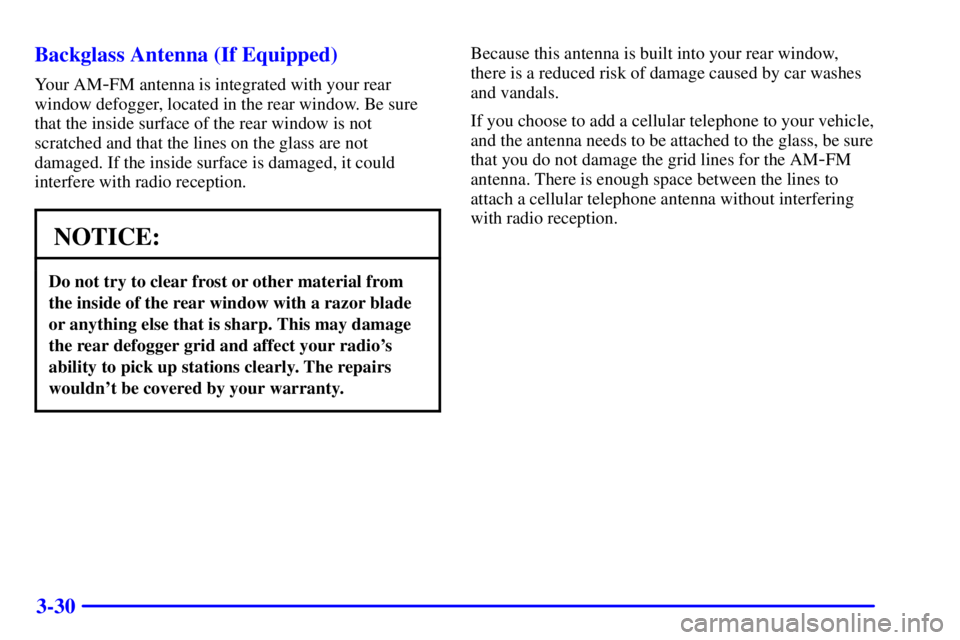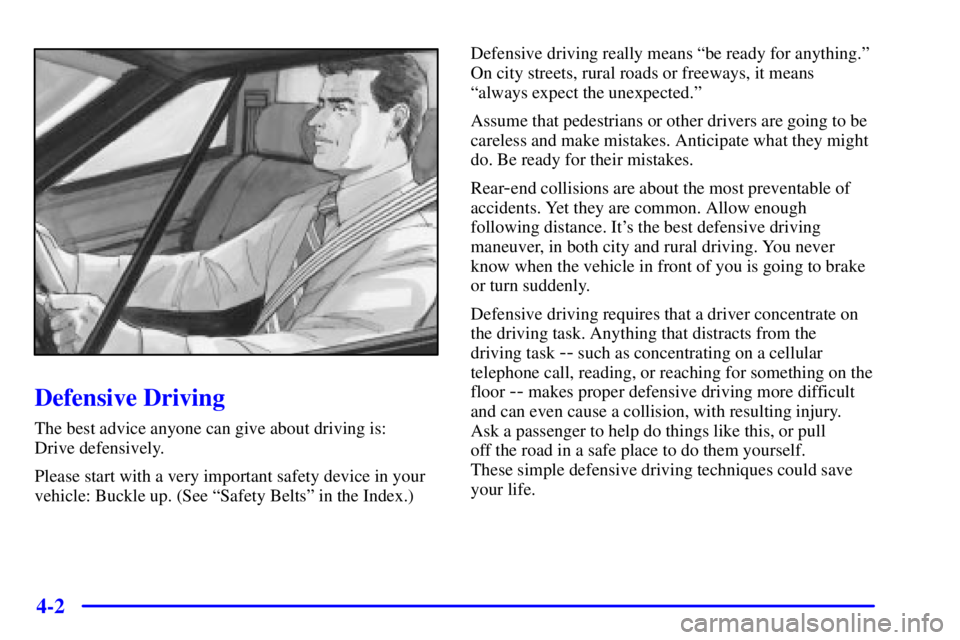Page 131 of 376

2-63
NOTICE:
Don't put papers and other things that burn into
the ashtrays. If you do, cigarettes or other
smoking materials could set them on fire,
causing damage.
To use the lighter, located inside the center front ashtray,
push it in all the way and let go. When it's ready, it will
pop back by itself.
NOTICE:
Don't hold a cigarette lighter in with your hand
while it is heating. If you do, it won't be able to
back away from the heating element when it's
ready. That can make it overheat, damaging the
lighter and the heating element.
Sun Visors
To block out glare, you can swing down the visors.
You can also swing them from front to side.
Visor Vanity Mirrors
Open the cover to expose the vanity mirror. If the
vehicle has the optional lighted vanity mirrors, the
lamps come on when you open the cover.
Accessory Power Outlet
(If Equipped)
Your vehicle has a 12-volt outlet which can be used to
plug in electrical equipment such as a cellular telephone,
a compact disc player, etc. It is located on the
passenger's side, near the floor. Remove the tethered cap
to use the outlet.
Page 188 of 376

3-27 Understanding Radio Reception
AM
The range for most AM stations is greater than for FM,
especially at night. The longer range, however, can
cause stations to interfere with each other. AM can pick
up noise from things like storms and power lines. Try
reducing the treble to reduce this noise if you ever get it.
FM Stereo
FM stereo will give you the best sound, but FM signals
will reach only about 10 to 40 miles (16 to 65 km).
Tall buildings or hills can interfere with FM signals,
causing the sound to come and go.
Tips About Your Audio System
Hearing damage from loud noise is almost undetectable
until it is too late. Your hearing can adapt to higher
volumes of sound. Sound that seems normal can be loud
and harmful to your hearing. Take precautions by
adjusting the volume control on your radio to a safe
sound level before your hearing adapts to it.
To help avoid hearing loss or damage:
�Adjust the volume control to the lowest setting.
�Increase volume slowly until you hear comfortably
and clearly.
NOTICE:
Before you add any sound equipment to your
vehicle
-- like a tape player, CB radio, mobile
telephone or two
-way radio -- be sure you can
add what you want. If you can, it's very
important to do it properly. Added sound
equipment may interfere with the operation of
your vehicle's engine, Delphi Delco Electronics
radio or other systems, and even damage them.
Your vehicle's systems may interfere with the
operation of sound equipment that has been
added improperly.
So, before adding sound equipment, check with
your dealer and be sure to check Federal rules
covering mobile radio and telephone units.
Page 191 of 376

3-30 Backglass Antenna (If Equipped)
Your AM-FM antenna is integrated with your rear
window defogger, located in the rear window. Be sure
that the inside surface of the rear window is not
scratched and that the lines on the glass are not
damaged. If the inside surface is damaged, it could
interfere with radio reception.
NOTICE:
Do not try to clear frost or other material from
the inside of the rear window with a razor blade
or anything else that is sharp. This may damage
the rear defogger grid and affect your radio's
ability to pick up stations clearly. The repairs
wouldn't be covered by your warranty.
Because this antenna is built into your rear window,
there is a reduced risk of damage caused by car washes
and vandals.
If you choose to add a cellular telephone to your vehicle,
and the antenna needs to be attached to the glass, be sure
that you do not damage the grid lines for the AM
-FM
antenna. There is enough space between the lines to
attach a cellular telephone antenna without interfering
with radio reception.
Page 193 of 376

4-2
Defensive Driving
The best advice anyone can give about driving is:
Drive defensively.
Please start with a very important safety device in your
vehicle: Buckle up. (See ªSafety Beltsº in the Index.)Defensive driving really means ªbe ready for anything.º
On city streets, rural roads or freeways, it means
ªalways expect the unexpected.º
Assume that pedestrians or other drivers are going to be
careless and make mistakes. Anticipate what they might
do. Be ready for their mistakes.
Rear
-end collisions are about the most preventable of
accidents. Yet they are common. Allow enough
following distance. It's the best defensive driving
maneuver, in both city and rural driving. You never
know when the vehicle in front of you is going to brake
or turn suddenly.
Defensive driving requires that a driver concentrate on
the driving task. Anything that distracts from the
driving task
-- such as concentrating on a cellular
telephone call, reading, or reaching for something on the
floor
-- makes proper defensive driving more difficult
and can even cause a collision, with resulting injury.
Ask a passenger to help do things like this, or pull
off the road in a safe place to do them yourself.
These simple defensive driving techniques could save
your life.
Page 211 of 376

4-20 Hydroplaning
Hydroplaning is dangerous. So much water can build up
under your tires that they can actually ride on the water.
This can happen if the road is wet enough and you're
going fast enough. When your vehicle is hydroplaning,
it has little or no contact with the road.
Hydroplaning doesn't happen often. But it can if your
tires do not have much tread or if the pressure in one or
more is low. It can happen if a lot of water is standing on
the road. If you can see reflections from trees, telephone
poles or other vehicles, and raindrops ªdimpleº the
water's surface, there could be hydroplaning.
Hydroplaning usually happens at higher speeds.
There just isn't a hard and fast rule about hydroplaning.
The best advice is to slow down when it is raining.
Driving Through Deep Standing Water
NOTICE:
If you drive too quickly through deep puddles or
standing water, water can come in through your
engine's air intake and badly damage your
engine. Never drive through water that is slightly
lower than the underbody of your vehicle. If you
can't avoid deep puddles or standing water, drive
through them very slowly.
Page 362 of 376
8-
8-1
Section 8 Customer Assistance Information
Here you will find out how to contact Pontiac if you need assistance. This section also tells you how to obtain service
publications and how to report any safety defects.
8
-2 Pontiac Cares
8
-3 What Makes Up Pontiac Cares?
8
-3 Customer Satisfaction Procedure
8
-5 Customer Assistance for Text Telephone
(TTY) Users
8
-5 Customer Assistance Offices
8
-7 GM Mobility Program for Persons
with Disabilities
8
-8 Pontiac Roadside Assistance Program
8
-9 Canadian Roadside Assistance8
-10 Courtesy Transportation
8
-11 Warranty Information
8
-12 Reporting Safety Defects to the United
States Government
8
-12 Reporting Safety Defects to the
Canadian Government
8
-13 Reporting Safety Defects to General Motors
8
-13 Ordering Owner Publications in Canada
Page 363 of 376
8-2
Pontiac Cares
With PONTIAC CARES, you are never more than
a phone call away from having your concern taken
care of.The PONTIAC CARES philosophy and elements are
designed to make you realize that Pontiac recognizes
you as a valuable customer, appreciates your purchase
decision, and is dedicated to taking care of the most
important person ... YOU! PONTIAC CARES is: A
valuable feature that comes with every Pontiac, a feature
that offers a multitude of benefits that can give you
safety, security, comfort and convenience.
Page 366 of 376

8-5
The BBB Auto Line Program is an out of court program
administered by the Council of Better Business Bureaus to
settle automotive disputes regarding vehicle repairs or the
interpretation of the New Vehicle Limited Warranty.
Although you are required to resort to this informal dispute
resolution program prior to filing any court action, use of
the program is free of charge and your case will generally
be heard within 40 days. If you do not agree with the
decision given in your case, you may reject it and proceed
with any other venue for relief available to you.
You may contact the BBB using the toll
-free telephone
number or write them at the following address:
BBB Auto Line
Council of Better Business Bureaus, Inc.
4200 Wilson Boulevard
Suite 800
Arlington, VA 22203
-1804
Telephone: 1
-800-955-5100
This program is available in all 50 states and the District
of Columbia. Eligibility is limited by vehicle age,
mileage and other factors. General Motors reserves the
right to change eligibility limitations and/or discontinue
its participation in this program.
Customer Assistance for Text
Telephone (TTY) Users
To assist customers who are deaf, hard of hearing, or
speech
-impaired and who use Text Telephones (TTYs),
Pontiac has TTY equipment available at its Customer
Assistance Center. Any TTY user can communicate with
Pontiac by dialing: 1
-800-833-PONT (7668).
(TTY users in Canada can dial 1
-800-263-3830.)
Customer Assistance Offices
Pontiac encourages customers to call the toll-free number
for assistance. If a U.S. customer wishes to write to
Pontiac, the letter should be addressed to Pontiac's
Customer Assistance Center.
United States
Pontiac-GMC Customer Assistance Center
P.O. Box 436008
Pontiac, MI 48343-6008
1-800-762-2737 or
1-800-833-7668 (For Text Telephone devices (TTYs))
Roadside Assistance: 1-800-ROADSIDE
(762-3743)